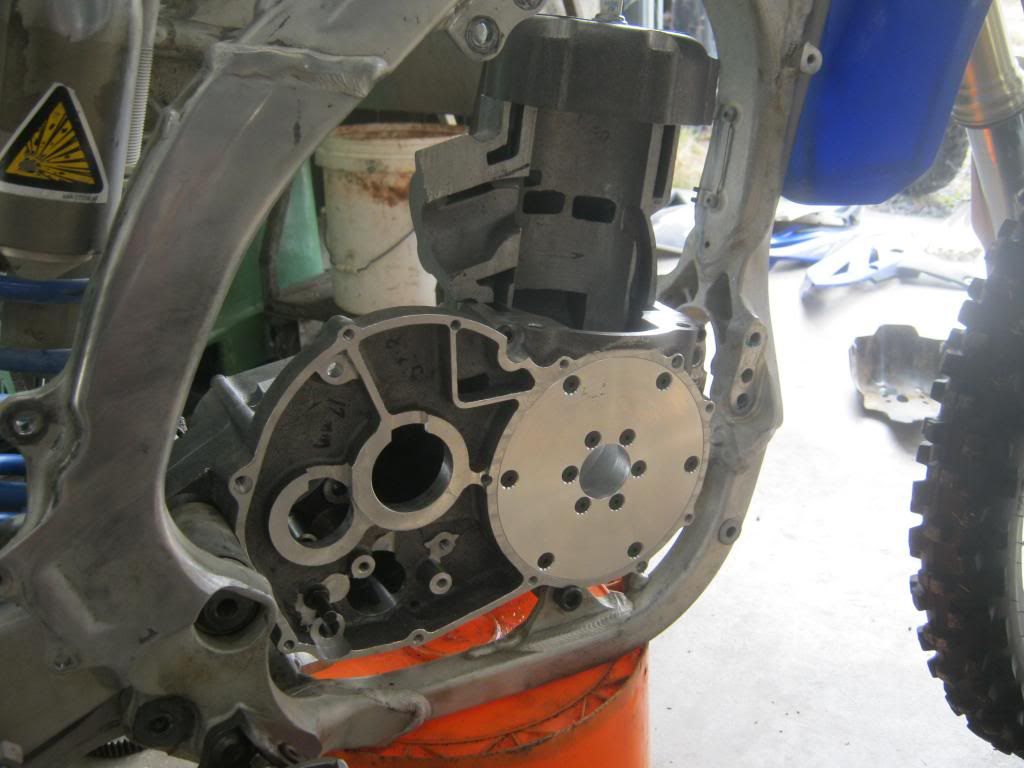



I know its not the sleeve valve one and I know it's a reversed cylinder layout, but believe me it won't be going with that particular cylinder in the photos!
Fact is, it's only one half of the cylinder pattern being used (for display purposes I guess). - and it does look impressive, I must say!
Will




The old " half a cylinder trick aye " this is the 180cc option.
This was the second cylinder ever cast for the gyro engine, water core slipped, so it was a reject. What else to do but cut it in half.
Don't be looking at the ports, I've been reprimanded by wobbly and have a new layout port under way including prevision for a power valve.





FLETTNER,
Do you make your cores with the Co2 hardening process?
Not too familiar with disc valves as yet, so I'm trying to figure out why all those c/sunk screws are there on the side of the case, - is that a removable back wall for the disc chamber?
Will.


CO2 sand is good for most cores, cheap core boxes, easy to use but can be brittle for intricate cores ( water jackets )
For the more tricky cores I use Shell Core sand,this needs metal core boxes as it sets at 180 degrees C.
If you don't have a CNC to cut these core boxes, just copy cast from the wood / bondi fill core boxes you would have already made.
This core box was copy cast from the original wood core box, then machined to fit together with screws. A little cleaning up on the inside surfaces are usually needed.
The disc valve plate you see here is to cover a cavity behind the valve. This plate seals off to allow cooling water to flow behind to help cool the crank case. Water comes from the pump, behind the valve then up under the exhaust port. out through the head after that.
Disc valve port still needs to be cut, we have attempted a test cut in a scrap peice of aluminium, not right just yet!


Thanks, that's all very interesting, - way in the past I have labouriously milled out CI coreboxes and the foundry then cooked up the cores using shell/coresand.
Interesting that the valve needs to be cooled, I seem to have fallen behind in understanding modern day practice!
PS. Guess I missed the bit where you said "to cool the crankcase", (not the valve).
Will.
Last edited by WilDun; 13th February 2014 at 10:55. Reason: correction


Getting back to the title of this thread, and back to the sixties and the "peaky" tiddlers like the twin cylinder fifties ( which more or less had to stay at over 20,000 revs in order to have any power and of course, were a bit difficult to negotiate the hairpins on.
At the IOM TT, I distinctly remember Ralph Bryans (Honda 50 twin) saying that when going up the mountain he had to keep the clutch slipping all the way to the top, constantly changing gears at the same time. - sounds like a nightmare to me! - times have changed now, but can we ever match the max HP of those things?
It was more or less a "pissing" competition to see who could do the most revs and who could have the most cylinders!
PS I'm sure Husa will be able to supply the photos.
BTW, I have dug up (x2 both unused) after market aircooled barrels for the RG 50 I believe - guess they're "competition" types ( don't know enough about port heights etc). Had them for quite a few years now, so what should I do? - just try to sell them? or maybe have a go at building a 'bucket' for someone to start out on? (I'm too old, heavy and infirm nowadays for that stuff. )
I would need a lot of good advice plus lots of tuning and building wisdom though - might be just too much of a challenge for me now! - who might be interested in them?
Will.
I really love that the old Honda 50s had bicycle brakes. Besides making them look killer, you have to respect the mental cases who raced them like they did!
There are currently 1 users browsing this thread. (0 members and 1 guests)
Bookmarks